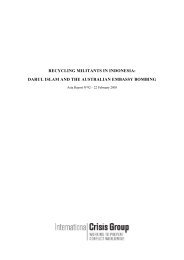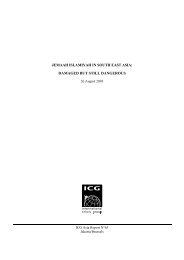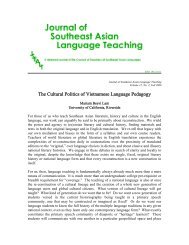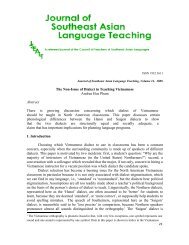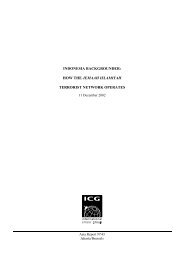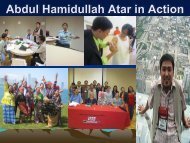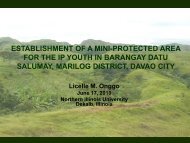Introduction - SEAsite - Northern Illinois University
Introduction - SEAsite - Northern Illinois University
Introduction - SEAsite - Northern Illinois University
Create successful ePaper yourself
Turn your PDF publications into a flip-book with our unique Google optimized e-Paper software.
Prentation Abstracts<br />
future. Actually, after Chintanakan-mai, the new way of thinking policy, has been<br />
adopted in 1986, rural life in Laos has highly changed: for example, land-forest<br />
allocation program has carried out and commercial farming of new cash crops has<br />
introduced. Also, another question to consider is addressed: who is the real actor of<br />
these changes? It is estimated that many of the changes had risen not by domestic<br />
people’s own initiatives but by outsider’s guidance and suggestions. Thus, actions<br />
of foreign governmental and nongovernmental organizations and private companies<br />
have made a huge impact on many aspects of political and economical issues<br />
of all over the regions in Laos.<br />
How we should expect the future of rural Laos? Is it going to move to the direction<br />
of centralized and standardized situation of northern Vietnam and Yunnan<br />
Province, or create a unique style to maintain its diversity and own characteristics?<br />
However, unfortunately, few reports on Laotian rural life are available. Therefore,<br />
based on the field surveys in the forest and farmland, this panel provides three<br />
topics, 1) plant uses for minor subsistence, 2) changes in land-forest use and 3)<br />
relationships between ethnic groups and occupation structure, to discuss about the<br />
close interaction between land, biological resources and people in Laos. We aim to<br />
argue the past, present and future of rural life in Laos from the comparative views<br />
with surrounding areas of the mainland Southeast Asia.<br />
Hirota Isao*, Nakanishi Asami**, Vilaysak Vanhna***<br />
and Eiji Nawata*<br />
Dynamics of Fallow Vegetation in Shifting Cultivation in<br />
<strong>Northern</strong> Laos: A Case Study in Houay Phee Village,<br />
La District, Udomxay Province<br />
* Graduate School of Agriculture, Kyoto <strong>University</strong>, Japan<br />
** Field Science Education and Research Center, Kyoto <strong>University</strong>, Japan<br />
*** Faculty of Forestry, National <strong>University</strong> of Laos<br />
Dynamics of fallow vegetation in shifting cultivation was studied in Houay<br />
Phee Village, La District, Udomxay Province, Lao P. D. R. by comparing various<br />
characteristics of fallow and conservation forests, which were able to be regarded<br />
as long fallow forest. DBH (diameter at breast height) and height of all woody<br />
plants in 20x20 m quadrats were investigated in a conservation forest, a secondary<br />
forest after the fallow period of more than 20 years and fallow forests with various<br />
fallow periods from 1 to 8 years. In each quadrat, 5 species were ranked according<br />
to the abundance and Shanon-Weaver index was calculated. Canopy openness was<br />
measured by photographs of the canopy. The biomass of woody plants increased<br />
gradually in the first 2 years, and rapidly in the 3rd year, and the increase of the<br />
biomass continued up to 8th year. The increase of biomass at early stages of the<br />
fallow period was mainly accounted for that of bamboo. The biomass of the other<br />
woody species increased as fallow periods prolonged. The biomass of bamboo<br />
was less than 5% of the whole biomass in the conservation forest. Among tree species,<br />
Euphorbiaceous plants were dominant in all quadrats except the conservation<br />
forest. Fagaceous and Juglandaceous plants, known as climax species in this area,<br />
appeared in later stages of fallow period. These species were especially abundant<br />
in the conservation forest. Bamboo was dominant species in all quadrats except<br />
the conservation forest. As it is unnatural that the biomass of bamboo have been<br />
decreased sharply in the fallow forests in about ten years and bamboo grows much<br />
faster than the other woody species at early growth stages, bamboo may have<br />
flourished more remarkably in recent years.<br />
Meanwhile, according to the interviews with the villagers, the main nontimber<br />
forest products (NTFPs), like cardamom, paper mulberry, peuak meuak<br />
(Boehmeria malabarica), or tiger grass, were begun gathering about from 5 to 10<br />
years ago. At this time, forest utilization of the villagers abruptly changed, while<br />
NTFPs is mainly gathered in the fallow forests. As a result, there have been two<br />
impacts, which are the shortening of fallow periods and the gathering of NTFPs,<br />
on the fallow forests in these about ten years, and that causes recent vegetation<br />
change in this area.<br />
Bret Johnston<br />
“Public” and “Private”: Notes on Media, Performance, and the<br />
Public Sphere in the Lao PDR<br />
Ph.D. Candidate, Department of Anthropology, <strong>University</strong> of Wisconsin-Madison,<br />
Wisconsin<br />
In light of the Lao government’s recent ban on the showing of Thai media in<br />
public places, my paper considers what may be an emerging distinction between<br />
ideas of “public” and “private” in contemporary Laos. In particular, such policies<br />
point to what may be a de facto recognition of the limits of state power on the part<br />
of the LPRP. I consider these issues by way of a comparison between two musical<br />
performances I observed in Laos in 2003, each of which is implicated with emerging<br />
media privatization in different ways.<br />
Dara Kanlaya, MS<br />
The Preservation of Palm leaf Manuscripts in Lao PDR<br />
Manager and Chief Editor of DOKKED Publisher.<br />
Permanent Advisor, Preservation of Lao Palm Leaf Manuscript Program<br />
National Library, Ministry of Information and Culture<br />
Lao PDR<br />
This paper deals with the palm leaf manuscripts’ preservation and transmission,<br />
as it was performed in the traditional way in the Lane Xang Kingdom in<br />
the past 600 –700 years. When Laos lost its independence, the leading role of<br />
manuscripts in the education were also degrading due to ongoing wars. In the<br />
past, there were two periods of great loss. There had been attempts to safeguard<br />
the manuscripts. During the cultural renaissance period between 1928-1941 and<br />
thereafter, the attempts of intellectuals and leading administration (cooperating<br />
with concerned foreign researchers), the renovation of monasteries and the copying<br />
of palm-leaf manuscripts were registered. Transliteration into Lao language<br />
and publication for school purpose by Chanthaboury Buddhist Council provided a<br />
broader dissemination to all Buddhist schools throughout the country.<br />
However, when the modern educational system developed with an emphasis<br />
on general education, the curriculum related to Buddhism was reduced and Lao<br />
manuscripts were no more in appropriate care.<br />
In 1988, the Ministry of Information and Culture ((MIC) carried out a<br />
national seminar on manuscripts preservation with financial support from The<br />
Toyota Foundation. Monks from 17 provinces have participated. They were invited<br />
to present their reports concerning the condition and number of palm leaf<br />
manuscripts in their respective provinces. Thereafter, the project staff members<br />
were nominated by the MIC in order to carry out inventory work in 6 provinces,<br />
namely: Vientiane Capital, Vientiane province, Luang Prabang, Khammouane,<br />
Savannakhet and Champassack. With the financial support of The Toyota Foundation,<br />
the project-team was able to work for 6 years, on an inventory in the selected<br />
monasteries.<br />
Although the survey work in 6 provinces was completed, only the manuscripts<br />
of 252 Buddhist monasteries could be registered, while Laos has more than<br />
2,800 monasteries in the whole country. In response to this need, the MIC applied<br />
for financial assistance from the Federal Republic of Germany. As a result, the<br />
following 10 years of “Lao-German Cooperation” (1992-2002) can be considered<br />
as an historical event in the protection of Lao manuscripts: All 17 provinces<br />
were covered and many important and ancient manuscripts were registered and<br />
microfilmed. The project activities emphasized on the participation of the public<br />
and thee mobilization of concerned villagers and monks in that way ensuring the<br />
involvement of people from all social strata. Regarding the study of these documents,<br />
the project has encouraged and supported Buddhist monks and National<br />
<strong>University</strong> in studying the traditional tham script, Pali language and ancient literature.<br />
The project came to an end in 2002, however 2 years of follow up work has<br />
been carried out. The final work was to establish four Preservation centers: (Luang<br />
Prabang, Vientiane Capital, Savannakhet and Champassak) where the Lao Buddhist<br />
Fellowship will continue the preservation and dissemination work on their<br />
own, but with close follow-up and technical assistance of the National Library<br />
The paper includes a lively series of photos showing the activities of fieldwork<br />
throughout the country.






